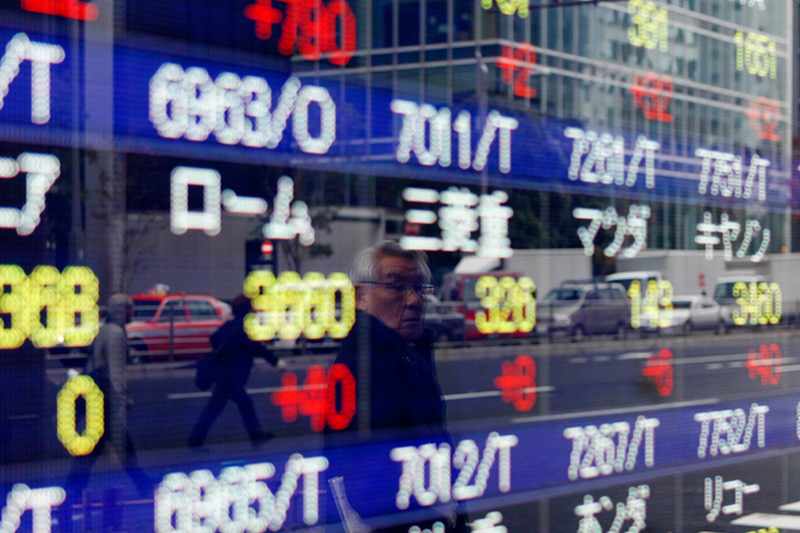* Asian stock markets: https://tmsnrt.rs/2zpUAr4
* MSCI Asia-Pacific index up 0.3 pct, Nikkei adds 0.2 pct
* Oil soft amid prospect of Russia, OPEC raising output
* European shares firmer
By Shinichi Saoshiro and Hideyuki Sano
TOKYO, April 16 (Reuters) - Asian stocks ticked up on Tuesday, staying near a nine-month high as hopes of stabilisation in the Chinese economy helped investors shrug off Wall Street's underperformance that followed disappointing bank earnings.
European shares are set to pick up, with futures of London and Frankfurt shares FFIc1 FDXc1 rising 0.2 to 0.3 percent.
MSCI's broadest index of Asia-Pacific shares outside Japan .MIAPJ0000PUS rose 0.3 percent, led by gains in China and India.
The index had risen to its highest level since July 2018 the previous day after strong export and banking data from China last week eased investors' concerns about the health of the world's second-largest economy.
Mainland Chinese shares .CSI300 rose 1.7 percent, partly on brisk home prices data while India's NSE index .NSEI rose 0.8 percent to a record high, surpassing its previous peak hit earlier this month. Japan's Nikkei .N225 edged up 0.2 percent.
"Recent Chinese data is boosting confidence in the Chinese economy while earnings have not been bad either," said Yukino Yamada, senior strategist at Daiwa Securities.
"Indian shares are rising on hopes on the country's elections. In the past they have tended to do well during a six-month period leading up to the election as well as one month after the election," she added.
Expectations that Chinese and U.S. trade negotiators would strike a deal soon also underpinned markets.
The U.S.-China trade dispute, signs of slowing global corporate earnings and business investment have all put pressure on riskier assets in the past year, so investors have been quick to lap up positive news.
Wall Street lost ground on Monday, dragged down as underwhelming bank earnings curbed investor enthusiasm. But while all three major U.S. stock indexes edged lower, the S&P 500 .SPX remained within a percent of its record high. .N
Safe havens such as bonds, which were on the defensive following the recent improvement in investor risk appetite, were given some reprieve.
The 10-year U.S. Treasury yield US10YT=RR was at 2.548 percent, edging back from a four-week high of 2.574 percent reached on Monday.
Spot gold was a shade lower at $1,286.21 an ounce XAU= and headed for its fourth straight days of losses. GOL/
Elsewhere in commodities, the recent rally in crude oil prices halted on the prospect of Russia and OPEC boosting production to fight for market share with the United States. O/R
U.S. West Texas Intermediate crude futures CLc1 were down 0.15 percent at $63.30 per barrel after losing nearly 0.8 percent the previous day.
U.S. crude had scaled a five-month high of $64.79 earlier this month.
Oil had rallied on tightening global supplies, as output has fallen in Iran and Venezuela amid signs the United States will further toughen sanctions on those two OPEC producers, and on the threat that renewed fighting could stop production in Libya.
The dollar, which tends to underperform when risk appetite increases, was steady at 96.980 .DXY against a basket of six major currencies, extending overnight losses.
Many investors are waiting on Chinese gross domestic product (GDP) data due on Wednesday for clues on the health of Asia's giant economy, a major pressure point for global growth over the past year.
A Reuters poll forecast China's first-quarter growth to have cooled to 6.3 percent on-year, the weakest pace in at least 27 years, but a flurry of measures to boost domestic demand may have put a floor under slowing activity in March. outlook for Asia critically hinges on the outlook of China's growth and the ongoing U.S.-China trade talks. On both fronts, policymakers and investors believe that the outcome of these two issues is turning more positive," wrote strategists at Bank of America Merrill Lynch (NYSE:BAC).
The euro stood flat at $1.13045 EUR= and the dollar shed 0.1 percent to 111.94 yen JPY= .
The Australian dollar fell 0.4 percent to $0.7146 AUD=D4 after minutes from a policy meeting this month showed that the country's central bank thought a cut in interest rates would be "appropriate" should inflation stay low and unemployment trend higher. by Shri Navaratnam & Kim Coghill)
